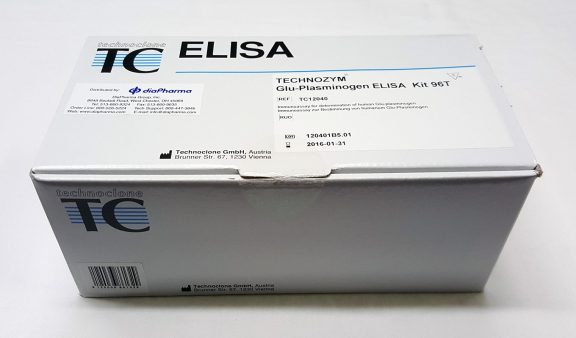
Technozym® Glu-Plasminogen ELISA
$0.00
Technozym® Glu-Plasminogen is a highly sensitive complete sandwich ELISA for the selective determination of Glu-Plasminogen in human plasma. The Glu-Plasminogen ELISA kit is based on two monoclonal antibodies; a catching antibody and a detecting antibody specific for the Glu-form of Plasminogen. The Glu-plasminogen ELISA is useful for the determination of Gluplasminogen levels, particularly in studies regarding throxmboembolic research, lytic research or in research studies of hyperfibrinolysis.
| Plate + Plate Cover | 12 x 8 well microtitre strips precoated with a monoclonal anti-Plasminogen antibody and blocked with 1% bovine serum albumin (BSA), lyophilized. (TC-Code GX) |
|---|---|
| Standard | 1x lyophilized Normal Plasma (TC-Code BJ) |
| POX-Antibody | 1x conjugated polyclonal anti Plasminogen antibodies (concentrated). (TC-Code BG) |
| Incubation Buffer | (PBS; pH 7,3); contains stabilizer protein; 0.05% proclin; and blue dye, 1 bottle, 90ml, ready for use (TC-Code NB) |
| Substrate – (green cap) | 1x 12 ml TMB (Tetramethylbenzidine) in substrate buffer containing H2O2. Ready to use. (TC-Code KN) |
| Stop Solution – (red cap) | 1x 12 ml 0.45 mol/l Sulphuric Acid (TC-Code KK) |
| Washing Buffer Concentrate- (1+11,5) | (PBS; pH 7,3) containing detergent; 0,01% merthiolat, 1 bottle, 80 ml (TC-Code NA) |
| Kit storage | Store all components at 2-8° C. |
Materials Required (but not supplied)
- Micropipettes and a multichannel micropipette; pipette tips.
- Glass or plastic test tubes for diluting the standard+samples.
- Laboratory bottles or beakers and graduated cylinders for diluting wash and incubation buffer.
- Distilled or deionized water.
- Absorbent paper towels.
- Microtitre plate washer (alternatively, washing can be performed manually using a multichannel pipette or repeating syringe).
- A microtitre plate reader equipped with a 450nm filter and, if possible, a 620 nm reference filter.
- A 37°C incubator.
- Graph paper.
The monoclonal antibodies employed in this test system recognize only uncleaved Glu-plasminogen. Thus, the results are not affected by the presence of plasmin-alpha-2-antiplasmin complexes or plasmin-modified Lys-plasminogen. The assay measures Glu-plasminogen in a range from 0.06-0.5 micrograms/milliliter. Normal plasma levels are 60-250 micrograms/milliliter. The inter- and intra-assay variations are less than 10% and 5%, respectively.
Measurement Principle
The TC Glu-plasminogen ELISA test is a solid phase enzyme immunoassay.
Background
Plasminogen is the inactive precursor of plasmin, the central enzyme responsible for fibrinolysis. Plasminogen, which is synthesized by the liver, is a 92,000 dalton single-chain glycoprotein. It circulates in plasma at a concentration of approximately 200 µg per ml with a half life of 2.2 days. Through the action of certain proteases such as tissue-type plasminogen activator or urokinase, a single peptide bond in the plasminogen molecule is cleaved to yield the two chain molecule, plasmin. Plasmin’s major function is physiologic clot dissolution through the degradation of the insoluble polymer fibrin into soluble fragments. Thus, the concentration of plasminogen is one of the numerous factors critically influencing the rate of fibrinolysis in vivo.
Plasminogen levels are often depressed in both acute and chronic hepatic disease. This may be due either to decreased synthesis or increased consumption during disseminated intravascular coagulation. In primary biliary cirrhosis or early common bile duct obstruction plasminogen values are normal or even elevated. Abnormally low plasminogen values have been found in patients with generalized hyperfibrinolysis and neonates with Lipström syndrome.